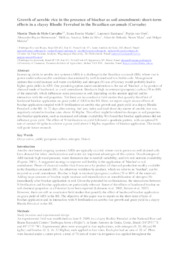Growth of aerobic rice in the presence of biochar as soil amendment: short-term effects in a clayey Rhodic Ferralsol in the Brazilian savanna (Cerrado).
Growth of aerobic rice in the presence of biochar as soil amendment: short-term effects in a clayey Rhodic Ferralsol in the Brazilian savanna (Cerrado).
Autoria: CARVALHO, M. T. de M.; MADARI, B. E.; BASTIAANS, L.; VAN OORT, P.; HEINEMANN, A. B.; SILVA, M. A. S. da; MAIA, A. de H. N.; MEINKE, H.
Resumo: Abstract: Increasing yields in aerobic rice systems (ARS) is a challenge in the Brazilian savannah (BS), where rice is grown under unfavourable conditions characterised by well drained and low fertile soils. Management options that could increase soil water availability and nitrogen (N) use efficiency would probably lead to higher grain yields in ARS. One promising option under consideration is the use of ?biochar?, a by-product of charcoal made of hardwood, as a soil amendment. Biochar is high in resistant (pyrogenic) carbon (70 to 80% of the material), which influences some processes in soil, depending on the amount applied and its interaction with the soil properties. Yet there are no conclusive field studies that quantify the effect of hardwood biochar application on grain yield of ARS in the BS. Here, we report single season effects of biochar application coupled with N fertilisation on aerobic rice growth and grain yield in a clayey Rhodic Ferralsol in the BS. At 72 days after sowing, leaf area index and total shoot dry matter of aerobic rice was negatively related to biochar rates above 16 Mg/ha. This effect might be related to changes in soil properties due biochar application, such as increased soil nitrate availability.We found that biochar applications did not influence grain yield. The effect of N fertilisation on yield followed a quadratic pattern, with an optimal N rate of around 46 kg/ha to achieve a grain yield above 3 Mg/ha, regardless of biochar application. The trends will guide future research.
Ano de publicação: 2012
Tipo de publicação: Parte de livro (capítulos de livros, trabalhos e resumos publicados em anais ou em coletâneas)
Unidade: Embrapa Arroz e Feijão
Palavras-chave: Arroz, Cerrado, Ferralsol, Oryza Sativa, Pinthosol, Pyrogenic C, Soil amendment, biochar, char
Observações
1 - Por padrão são exibidas publicações dos últimos 20 anos. Para encontrar publicações mais antigas, configure o filtro ano de publicação, colocando o ano a partir do qual você deseja encontrar publicações. O filtro está na coluna da esquerda na busca acima.
2 - Para ler algumas publicações da Embrapa (apenas as que estão em formato ePub), é necessário ter, no celular ou computador, um desses softwares gratuitos. Sistemas Android: Google Play Livros; IOS: iBooks; Windows e Linux: software Calibre.
Acesse outras publicações
Acesse a Base de Dados da Pesquisa Agropecuária (BDPA) para consultar o acervo completo das bibliotecas da Embrapa.

